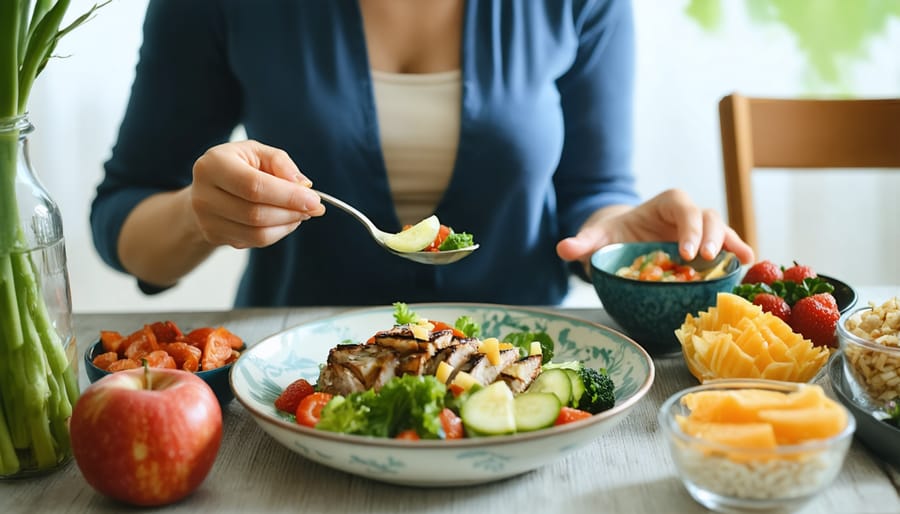
Have you ever noticed how a slice of warm apple pie can instantly transport you back to your grandmother’s kitchen, or how a bowl of ice cream becomes an irresistible comfort after a challenging day? The profound connection between food and emotions runs deeper than mere sustenance – it’s woven into the fabric of our daily experiences, memories, and coping mechanisms.
Our relationship with food is beautifully complex, acting as both a source of nourishment and an emotional companion through life’s ups and downs. Research shows that up to 75% of overeating is triggered by emotions rather than physical hunger, making it crucial to understand this delicate dance between our plate and our feelings.
Think of food emotions as the invisible threads connecting our taste buds to our hearts – sometimes bringing joy and celebration, other times serving as a band-aid for stress or loneliness. Whether it’s the euphoria of biting into a perfectly ripe mango or reaching for cookies when anxiety strikes, these emotional eating patterns shape not just our waistlines, but our overall well-being.
In this journey together, we’ll explore how to recognize emotional eating triggers, develop healthier coping strategies, and transform our relationship with food from an emotional crutch into a source of mindful nourishment. Because understanding your food emotions isn’t about judgment – it’s about awareness, growth, and choosing joy in every bite.
The Science Behind Food-Emotion Connection
Your Brain on Comfort Food
Ever wonder why a warm bowl of mac and cheese feels like a hug from the inside? It’s not just your imagination – there’s fascinating food psychology at play when we reach for comfort foods. When we eat these familiar favorites, our brains release feel-good chemicals like serotonin and dopamine, creating a natural mood boost.
Think of your comfort food cravings as your brain’s speed dial to happiness. When you bite into that chocolate chip cookie that reminds you of childhood afternoons at grandma’s house, your brain isn’t just processing sugar and butter – it’s activating memories and emotional connections that make you feel safe and content.
Different foods trigger different responses in our brains. Carbohydrate-rich foods like pasta can increase serotonin production, helping explain why we often crave starchy foods when feeling down. Meanwhile, foods high in healthy fats, like avocados or nuts, can help stabilize our mood by supporting brain function.
But here’s something interesting: your personal comfort foods are as unique as your fingerprint. While some might find solace in a bowl of ice cream, others might feel most comforted by a steaming bowl of soup. These preferences often develop from our earliest food experiences and cultural background, creating a deeply personal emotional menu that our brains recognize as comfort food.

The Stress-Eating Cycle
Have you ever found yourself reaching for that bag of chips or pint of ice cream after a particularly stressful day? You’re not alone. As someone who’s been there countless times, I understand how stress and food become intimately connected in our lives.
When stress hits, our bodies release cortisol, often called the “stress hormone.” This surge triggers cravings for high-calorie, sugary, and fatty foods – exactly the kind we tend to label as “comfort foods.” It’s not just in our heads; there’s a biological reason we seek these foods when we’re stressed.
Picture this: You have a challenging day at work, and by evening, you’re automatically drawn to the kitchen. Before you know it, you’re stress-eating your way through various snacks. This temporary relief feels good in the moment, but often leads to guilt and more stress, creating a cycle that can be hard to break.
What makes this cycle particularly tricky is that it can become a learned response. Our brains begin to associate emotional relief with certain foods, making it our go-to coping mechanism. The more we rely on food to manage stress, the stronger this connection becomes.
Understanding this pattern is the first step toward making positive changes. Remember, recognizing these behaviors doesn’t mean you’re failing – it means you’re becoming more aware and empowered to make different choices.

Common Emotional Eating Triggers
Social and Environmental Triggers
Have you ever noticed how certain situations seem to trigger an irresistible urge to reach for comfort food? You’re not alone. Our environment plays a significant role in shaping our relationship with food, often in ways we don’t immediately recognize.
Social gatherings, for instance, can be particularly challenging. Whether it’s a family celebration or after-work drinks, these events often center around food and can trigger emotional eating patterns. The pressure to participate, combined with the festive atmosphere, might lead to eating beyond hunger cues.
Work stress is another common trigger. That deadline-induced tension might have you gravitating toward the vending machine or reaching for sugary snacks to cope with anxiety. Similarly, scrolling through social media during lunch breaks, surrounded by perfectly curated food photos, can influence our eating choices and emotional responses to food.
Even our home environment can impact our eating behaviors. A cluttered kitchen, for example, might increase stress levels and lead to mindless snacking. Weather changes, too, play their part – many of us reach for comfort foods on rainy days or during winter months.
Understanding these triggers isn’t about judgment; it’s about awareness. By recognizing the external factors that influence our eating patterns, we can begin to develop more mindful approaches to food. Remember, these triggers affect everyone differently, and what matters most is finding strategies that work for you personally.
Internal Emotional States
Have you ever noticed how your mood affects what and how you eat? Our emotional state plays a pivotal role in our relationship with food, often acting as an invisible hand guiding our food choices and eating patterns. When we’re feeling stressed, many of us reach for comfort foods that remind us of happier times or provide a quick mood boost. During moments of joy, we might celebrate with special treats or indulge in our favorite dishes.
Understanding these internal emotional states is crucial for developing a healthier relationship with food. When we’re anxious, our bodies might crave sugary or high-carb foods that provide quick energy and temporarily boost serotonin levels. Feeling lonely or sad might drive us toward foods that remind us of connection and comfort, like mom’s famous chocolate chip cookies or grandma’s chicken soup.
But it’s not just negative emotions that influence our eating habits. Excitement and happiness can also shape our food choices, sometimes leading to mindless snacking or overindulgence during celebrations. The key is becoming aware of these emotional patterns without judgment. By recognizing how different feelings impact our food choices, we can start making more conscious decisions about what, when, and why we eat.
Take a moment to reflect on your own emotional eating patterns. What foods do you turn to when you’re feeling down? What do you crave when you’re stressed? This self-awareness is the first step toward building a more balanced relationship with food.
Practical Strategies for Emotional Eating Management
Mindful Eating Practices
Have you ever caught yourself mindlessly finishing a bag of chips while scrolling through social media? I certainly have, and it’s a common experience many of us share. The good news is that developing mindful eating habits can transform our relationship with food and emotions.
Start by creating a peaceful eating environment. Turn off the TV, put away your phone, and focus solely on your meal. Take a moment to observe your food’s colors, textures, and aromas before taking your first bite. This simple practice helps you connect with your food on a deeper level and recognize true hunger signals.
Practice the “first bite” ritual: Take your initial bite with complete awareness, noting the flavors and sensations. Chew slowly and deliberately, putting your utensils down between bites. This technique naturally slows your eating pace, allowing your body to register fullness more effectively.
Try the “pause and reflect” method during meals. Halfway through, take a brief moment to assess your hunger level and emotional state. Are you eating because you’re truly hungry, or are other feelings driving your appetite? There’s no judgment here – just awareness.
Keep a simple food-mood journal for a week. Note not just what you eat, but how you feel before, during, and after meals. Patterns often emerge, helping you understand your emotional triggers around food. Remember, this isn’t about criticism – it’s about curiosity and self-discovery.
Incorporate the “5-5-5” technique: Take 5 deep breaths before eating, spend at least 5 minutes preparing your meal mindfully, and sit for 5 minutes after finishing. This creates natural boundaries around meal times and helps you tune into your body’s signals.
These practices aren’t about perfection – they’re about progress. Start with one technique that resonates with you and gradually build your mindful eating toolkit. With time and patience, you’ll develop a more balanced, aware approach to nourishing both your body and soul.

Alternative Coping Mechanisms
When emotions run high, reaching for comfort food might feel like the natural response, but there are numerous healthier ways to process and manage your feelings. Let’s explore some practical alternatives that can help break the cycle of emotional eating.
Physical activities offer an excellent outlet for emotional release. A brisk walk around the neighborhood, a quick yoga session, or even dancing in your living room can shift your mood and energy. I personally found that taking a 10-minute stretching break when stressed helps me reconnect with my body in a nurturing way.
Creative expression provides another powerful avenue for emotional processing. Try journaling about your feelings, sketching, coloring, or crafting – these activities engage your mind and hands while helping you work through difficult emotions. One of my readers shared how starting a gratitude journal helped her transform her evening snacking habit into a meaningful self-reflection practice.
Mindfulness techniques can also be incredibly effective. Deep breathing exercises, meditation, or simply sitting quietly with a cup of herbal tea can help you pause and identify what you’re really feeling. Consider creating a “calm corner” in your home with comfortable pillows, inspiring books, and perhaps some essential oils.
Connection is another powerful tool. Call a friend, join an online support group, or spend time with pets. Sometimes, what we interpret as hunger is actually a need for companionship or understanding. Remember, seeking support isn’t a sign of weakness – it’s a smart strategy for emotional wellbeing.
The key is finding what works for you and building a personalized toolkit of alternatives that feel authentic and sustainable.
Creating a Supportive Environment
Your environment plays a crucial role in your relationship with food, and creating a supportive space can help you develop healthier eating patterns. Start by organizing your kitchen in a way that promotes mindful choices. Keep nutritious snacks visible and easily accessible while storing less nutritious options in less prominent places.
Consider setting up a dedicated dining area where you can eat without distractions. I’ve found that having a welcoming space with comfortable seating and good lighting makes mealtimes more enjoyable and encourages mindful eating. Try adding some fresh flowers or plants to create a calm, positive atmosphere.
Establish regular meal times and stick to them as much as possible. This helps regulate your body’s hunger signals and reduces impulsive eating. Keep a well-stocked pantry with wholesome ingredients that make you feel good, both physically and emotionally.
Another helpful practice is to designate specific areas for different activities. Avoid eating at your desk or in front of the TV, as this can lead to mindless consumption and disconnect you from your food experience. Instead, create clear boundaries between eating spaces and working or entertainment areas.
Remember to make your kitchen a judgment-free zone. Remove items that trigger negative feelings about food or body image, such as diet books or strict meal plans. Instead, surround yourself with tools and resources that support your journey toward a balanced relationship with food, like beautiful cookware that inspires you to prepare nourishing meals.
As we’ve explored throughout this journey, our relationship with food is deeply intertwined with our emotions. Understanding this connection isn’t just about recognizing patterns – it’s about empowering ourselves to make mindful choices that serve both our emotional and physical well-being.
Remember, there’s no one-size-fits-all approach to managing emotional eating. What matters most is finding strategies that resonate with your unique lifestyle and needs. Whether it’s practicing mindful eating, keeping a food-emotion journal, or developing new stress-management techniques, small steps can lead to meaningful changes.
I’ve witnessed countless women in our community transform their relationship with food by simply becoming more aware of their emotional triggers. Start by implementing one or two strategies we’ve discussed – perhaps beginning with the mindful eating exercise or creating your own emotional toolkit for challenging moments.
Be patient and gentle with yourself along this journey. Progress isn’t always linear, and that’s perfectly okay. Focus on building a positive, nurturing relationship with both your emotions and your food choices. Remember, you’re not alone in this experience – we’re all learning and growing together.
By understanding and honoring the connection between our emotions and eating habits, we can create a more balanced, joyful approach to nourishing ourselves – both body and soul. Let’s continue supporting each other as we cultivate healthier, more mindful relationships with food.



